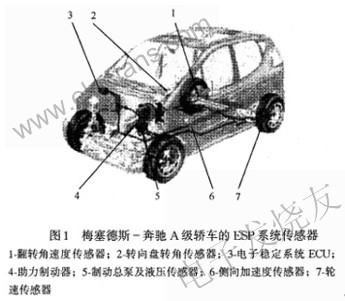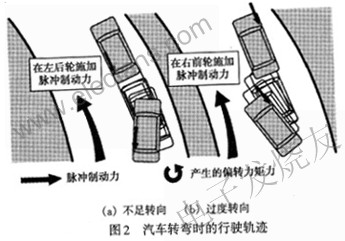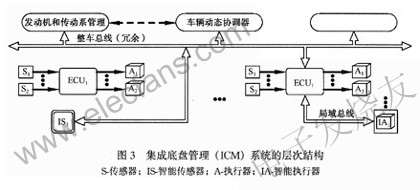Principle Analysis of Automotive Electronic Stability System (ESP)
The automotive electronic stability system or the dynamic stability control system (ESP) is an anti-lock braking system ABS, a driving anti-skid control system ASR, an electronic braking force distribution system EBD, a traction control system TCS and an active body yaw control. The combination of basic functions such as the system AYC (Active Yaw Control) is a new type of active safety system for automobiles. The system is an automotive chassis electronic control system jointly developed by Bosch (B0SCH) and Mercedes-Benz (MERCEDES-BENZ).
This article refers to the address: http://
During the driving process of the car, due to external disturbances, such as sudden changes in pedestrians, vehicles or the environment, the driver takes some emergency avoidance measures to make the car enter an unstable driving state, that is, a dangerous state that deviates from the predetermined driving route or the turning trend. The ESP car can identify and determine the unstable driving trend of the car in a very short time of a few milliseconds. Through the intelligent electronic control scheme, the car's drive transmission system and braking system produce accurate response. Properly eliminate these unstable driving trends of the car, keep the car driving route and prevent rolling, and avoid traffic accidents.
The ESP system is a huge breakthrough in the active safety measures of the car. It controls the safe occurrence of the accident by controlling the possibility of the accident, so that the car can ensure the stability and safety of driving in the extremely harsh driving environment.
1. Composition of automotive electronic stability system
Based on ABS and ASR sensors, ESP increases the yaw rate sensor, body flip angle sensor, side acceleration sensor, hydraulic pressure sensor and steering wheel angle sensor in the steering wheel. The most important of these is the body-turning angular velocity sensor, which is a similar product to the rotating angular velocity sensor used on space shuttles and spacecraft. The body flip angle sensor is like a compass, which monitors the exact attitude of the car in a timely manner and monitors every possible roll angle of the car. Other sensors monitor the speed of the car and the speed difference of each wheel, monitor the steering angle of the steering wheel and the horizontal lateral acceleration of the car. When the brake occurs, the braking force is monitored and the braking force distribution of each wheel is monitored.
The ESP system includes 9 distance control functions including distance control, anti-driver sleepiness, speed limit recognition, parallel warning, parking entry, night vision, ambient identification, integrated stability control and brake assist (BAS). By combining nine smart active safety technologies, ESP can reduce the driver's risk of losing control of the vehicle by about 80%.
ESP intelligent on-board computer control system, through various sensors, monitor the driving state of the vehicle and the driver's driving intention at any time, and issue various instructions to the actuator in time to ensure the car under braking, acceleration, steering and other conditions. Driving stability.
Figure 1 shows the installation of various sensors and electronic stability system ECUs of the automotive electronic stability system ESP in a car. The ECU is equipped with two 56 kB memory microcomputers. The ESP system uses these two microcomputers and various sensor signals to continuously monitor the electronic modules in the car, the working status of the system and the driving posture of the car. For example, the speed sensor will self-test every 20ms. The ESP system also utilizes the advanced functions of the anti-lock braking system ABS, the brake boosting system BAS and the anti-skid control system ASR through the signal communication network between the in-vehicle electronic modules. In an emergency, if the nervous driver does not exert enough braking force, the brake boosting system BAS will automatically increase the braking force. When the ESP system fails and does not work properly, the ABS and ASR systems can work as expected to ensure normal driving and braking.

The function of the ESP system is not simply the sum of the ABS and ASR functions, but the sum of the ABS and ASR functions, so that the car can maintain driving stability under extremely harsh conditions. The safety concept of the Mercedes-Benz A-Class is to achieve the greatest possible protection for the safety of the car and the occupants through the intelligent integration of the advanced electronic control module with the hydraulic mechanical actuator.
2. The working principle of automotive electronic stability system
All forces acting on the car from the outside, including braking force, driving force, and any kind of lateral force, cause the car to rotate around its center of mass. According to this principle, the ESP system corrects the tendency of excessive steering or understeering by the interference of the brake system and the drive transmission system when the vehicle enters an unstable driving state, so that the vehicle maintains a stable driving state.
In the ROM of the microcomputer control system, standard technical data in the control program is stored in advance. When the vehicle sensor monitors and transmits various data of the driving state of the vehicle to the ECU randomly, the ECU immediately recalls the pre-stored standard data and compares it with it to determine whether the car has an unstable driving tendency and the degree of instability and the reason. Once it is determined that the car has an unstable driving trend, the ESP system will automatically replace the driver to control the car, and the microcomputer control system will issue commands to the brake actuator and the engine actuator to take the most favorable safety measures to correct the driving force and braking force. Prevent the occurrence of potentially dangerous situations and restore the car to a safe and stable driving state.
The safety measure implemented by the microcomputer control system command means that when the vehicle sensor detects that the vehicle has a tendency to reverse or deviate from the driving route demanded by the driver, the system can selectively brake the front or rear wheels of a single automobile, or If necessary, increase or decrease the output torque of the engine and adjust the driving force.
Figure 2 is a schematic representation of the trajectory of a car as it travels on a turning road. As shown in Fig. 2(a), when the car enters a curve, if the driver turns the steering radius of the car through the steering wheel to be larger than the curve radius, this situation is called insufficient steering. If the car speed is too fast, the car may rush out of the road. The yaw rate sensor installed in the car will measure the steering deviation. The side acceleration sensor will measure the right acceleration and the steering wheel angle sensor will measure the left understeer, and immediately monitor the dangerous trend of the road. The signal is input to the ECU in the electronic stability system. The ECU immediately commands the pulse braking force on the left rear wheel, which produces an inward yaw moment at the car's center of mass, forcing the car to deflect an angle around the center of mass. At the same time, the ECU immediately instructs the engine to reduce the output torque, lowers the speed of the car, and replaces the driver to make the steering angle of the car slightly larger, so that the car can drive at the steering angle required by the radius of the curve and return to the correct route.
Conversely, see Figure 2(b), the initial position of the car's travel trajectory. If the driver's steering wheel is turned too fast, so that the turning radius of the car is smaller than the radius of the curve, this situation is called oversteer. If the car is too fast, the car may flip outward due to centrifugal force. The yaw rate sensor, side acceleration sensor and steering wheel angle sensor installed in the car monitor the dangerous tendency of this flipping, immediately input the signal into the ECU in the electronic stability system, and the ECU promptly commands the pulse braking on the right front wheel. The braking force generates an outward deflection torque at the center of mass of the car, counteracting the centrifugal turning moment, forcing the car to deflect outward from the center of mass by an angle, thereby preventing the tendency of the car to roll over. At the same time, the ECU control quickly reduces the driving force, lowers the speed of the car, and replaces the driver to make the steering angle of the car slightly smaller, so that the car can travel at the steering angle required by the radius of the curve.

In summary, the automotive electronic stability system ESP uses two different control methods when the vehicle has an unstable driving trend, so that the vehicle eliminates unstable driving factors and restores and maintains the predetermined driving state of the vehicle. The two control methods are: First, the ESP system forces the braking force applied to each wheel to force the car to rotate around its center of mass by precisely controlling the braking process (pulse braking) of one or more wheels. The rotating torque, while adjusting the direction of the car instead of the driver. Secondly, when necessary (such as the speed of the car is too fast, the engine drive torque is too large), the ESP system automatically adjusts the output torque of the engine to control the speed of the car.
By adopting the above two technical measures, when the car performs the serpentine line test, the car can be effectively prevented from being turned over. The ESP system not only improves the stability of the car on dry roads, but also works when the road surface is poorly attached, such as icing, slippery, and gravel. Under the above unfavorable conditions, the adhesion between the wheel and the road surface is reduced, and even the best driver is difficult to keep the high-speed car on the predetermined route, the car is prone to side slip and deviation, and the direction is stable. Sex, even during a sharp turn, a rollover accident, when you need an ESP system.
3. Reliability of automotive electronic stability system
Since 1994, Mercedes-Benz has conducted a comprehensive validation test of the suitability and reliability of ESP systems.
In the ROM of the microcomputer control system, the standard technical data in the pre-stored control program should be derived from a large number of real vehicle test data. However, due to the actual vehicle test without safety guarantee, it may cause irreparable safety accidents. Therefore, the standard technical data was obtained using the simulator. A large number of experimentally collected data is input into the simulator, which can simulate many complicated road conditions and driving processes. Then, through 80 simulators of Mercedes car owners, the simulated road driving test with a speed of 100km/h was carried out to obtain the response of various performance cars in various driving processes. The simulator detection method is both safe and can get a lot of data that cannot be measured by the actual vehicle test. For example, in the four corners of the test site, the simulator simulates the sudden freezing of the road surface, which will reduce the adhesion between the wheel and the road surface by more than 70% within a few meters. If the car does not have an ESP system, 78% of the drivers will not be able to stabilize their car on ice and snow, or they may suffer the damage caused by the car's three consecutive flips. With the ESP system, all drivers who have participated in the simulation test can avoid car rollover accidents.
In 1995, the Mercedes-Benz S-Class sedan began to install the ESP system. The outstanding safety performance of the ESP system greatly reduced the possibility of the car turning over under various road conditions and during cornering. At the same time, the braking distance of the car on the curved road and the slippery road surface is shortened, and the driving ability in the car line is enhanced in the curved road. In 1998, the Mercedes-Benz A-class mini-car was also installed. The ESP system makes this A-class mini-car with a large number of high-tech developments overcome the shortcomings of the vehicle body, which is prone to lateral inversion and cause personal injury and property loss when the car is turning sharply at a small turning radius. A miniature car with excellent safety performance.
At present, Mercedes-Benz's S600, CL600, sL600, FA30, E320, 4MATIC and high-performance E55AMG and C43AMG models are equipped with ESP system. In 2002, all G-Class cars were installed.
4. A new generation of automotive electronic stability systems
The new generation of automotive electronic stability system integrates Active Steering Control (ASC) and Active Suspension Control (ADC) with optional suspension mode and ESP to enable dynamic stability control technology for vehicles. It is more perfect and improves the driving stability and steering stability of the car under any circumstances.
In non-hazardous driving situations, the active steering control system makes driving more flexible and increases driving pleasure. In dangerous driving situations, the active steering control system together with the braking system and the engine management system control the driving stability and ride comfort of the vehicle.
5. Integrated stability control system
The integrated stability control system has integrated control of all active systems on the vehicle, such as drive, brake and steering systems, under any given conditions. Compared with the current active vehicle stability control system, the integrated stability control system can continuously control the vehicle and realize the personalization of the control.
6. Development of electronic control system for automobile chassis
(1) Integrated chassis management system
With the rapid development of electronic technology, especially large-scale integrated circuits and micro-computer technology, the degree of electronicization of automobiles is getting higher and higher. The undercarriage of the car also changed the mechanical structure that relied entirely on hydraulic or pneumatic actuators to transmit force, and began to step into electronic servo control (By-wire, the electrical signal between the control and the actuator is not mechanical) At the stage of the connection, the integrated chassis control system has also begun to appear. The advanced chassis electronic control system optimizes the adhesion between the wheel and the ground, significantly improving the car's power, safety and comfort.
The automotive chassis electronic control system will gradually form an integrated chassis management (ICM) system. The system will integrate all the chassis electronic control subsystems to realize the sharing of hardware, energy and information of each subsystem to maximize the synergy brought by system integration and improve the safety, comfort and economy of the vehicle. . Figure 3 shows the hierarchical structure of the ICM system. The upper layer of the structure diagram contains only some key monitoring functions. At this level, the system manages the engine, drive train, chassis system, etc. through a “coordinator†ECU. Blank squares represent other features such as navigation and ACC functions. The lower layer of the structure diagram represents the current electronic control system, but they are no longer separate modules, but coordinate work under the supervision and management of the upper unit. Sensors and actuators in the system can be divided into two categories: traditional and intelligent. Traditional sensors and actuators have only a direct physical connection to their respective ECUs, while smart sensors and actuators and ECUs use a bus interface to transfer data. In general, they all have self-diagnostic capabilities and a certain sensor signal processing capability.

(2) Dynamic Body Control (Dynamic Body Control)
For multi-purpose sports cars (SUVs) and other high-profile cars, the power body control system maximizes steering stability while enhancing ride comfort. When the car is driving off-road, the axles work together to achieve better traction performance. The power body control system uses one or two active balance bar modules to prevent the vehicle from shaking left and right when cornering by applying an adjustable preload to the balance bar. When the car body is to be tilted, the accelerometer monitors the tendency of the car to slide, and transmits the signal to the control system ECU. The ECU commands the pressure oil to the balance bar actuator. The pressure oil generates the force according to the accelerometer. The magnitude of the lateral acceleration and the time the car is shaking are determined.
All global AC input voltages are catered for from 90VAC to 264VAC single phase and US, AU, EU, UK, KR, CN interchangeable ac blade wall plug adapters are Class II rated(without earth pin). This high efficiency plug adapter is designed to provide customers with global solutions utilizing the latest in green power technology.
Power Plug Adapter,Multiple Plug Adapter,Power Adapter,Interchangeable Plug Power Adapter
Shenzhenshi Zhenhuan Electronic Co Ltd , http://www.szzhpower.com